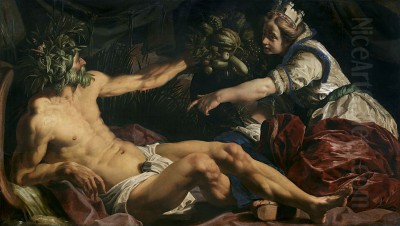
Abraham Janssens van Nuyssen, often known simply as Abraham Janssens, stands as a pivotal figure in the rich tapestry of Flemish Baroque painting. Active primarily in Antwerp during the late 16th and early 17th centuries (circa 1573/1575–1632), Janssens was a highly respected history painter whose work bridged the gap between late Mannerist traditions and the burgeoning High Baroque style, famously championed by his slightly younger contemporary, Peter Paul Rubens. Janssens's art is characterized by its powerful synthesis of Italian influences, particularly the dramatic realism of Caravaggio, with a robust Flemish sensibility and underlying classical structure. He was, for a significant period, considered Antwerp's foremost painter, renowned for his compelling religious, mythological, and allegorical compositions.
Early Life and Artistic Formation in Antwerp
Abraham Janssens was born in Antwerp, a thriving metropolis and a major European center for arts and commerce, though struggling under the political and religious tensions of the time. The exact year of his birth is debated, with sources suggesting either 1573 or, more commonly, 1575. Regardless, he entered the world during a period of artistic transition in the Southern Netherlands. His formal artistic training began around 1583 or 1585 when he became a pupil of Jan Snellinck.
Jan Snellinck (c. 1549–1638) was a respected painter known for his large-scale historical and battle scenes, as well as tapestry designs. Training under Snellinck would have provided Janssens with a solid foundation in the Antwerp tradition, emphasizing draftsmanship, composition, and the narrative demands of history painting. This apprenticeship laid the groundwork for the technical proficiency evident throughout Janssens's career. Antwerp's artistic environment at this time was still influenced by late Mannerism, but also receptive to new ideas filtering in from Italy.
The Transformative Italian Journey
Like many ambitious Northern European artists of his generation, Janssens recognized the necessity of traveling to Italy to complete his artistic education. He embarked on this crucial journey sometime between 1598 and 1601, spending a significant period, primarily in Rome. This Italian sojourn proved profoundly influential, exposing him directly to the masterpieces of classical antiquity, the High Renaissance, and, most importantly, the revolutionary art of Michelangelo Merisi da Caravaggio.
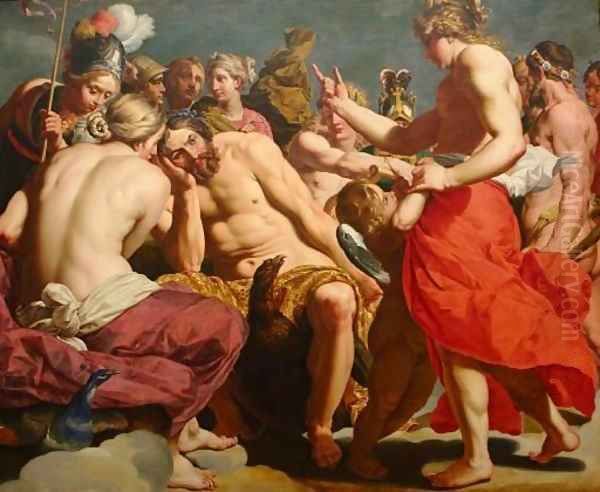
Caravaggio's dramatic use of chiaroscuro (strong contrasts between light and dark), his unidealized, often plebeian figure types, and the raw emotional intensity of his religious scenes made an indelible impact on Janssens. The encounter with Caravaggio's work fundamentally shifted Janssens's artistic direction, pushing him towards a more forceful, realistic, and emotionally charged style. He absorbed the lessons of tenebrism, using directed light not just for modeling form but for heightening drama and focusing the viewer's attention.
Beyond Caravaggio, Janssens also studied the works of High Renaissance masters like Raphael, whose clarity of composition and idealized forms offered a counterpoint to Caravaggio's raw naturalism. He likely also absorbed influences from the Bolognese school, particularly the classicizing tendencies of Annibale Carracci and his academy, which sought to synthesize Renaissance grace with Venetian color and Lombard realism. This blend of influences would become characteristic of Janssens's mature style.
Return to Antwerp: Establishing a Reputation
Janssens returned to his native Antwerp around 1601-1602, equipped with firsthand knowledge of the latest Italian artistic developments. He quickly established himself within the city's competitive art scene. In 1601, he was admitted as a master into the prestigious Guild of Saint Luke, the official body regulating artists and craftsmen in Antwerp. This marked his formal entry into the professional artistic community.
Shortly after becoming a master, Janssens married Sara Goetkint (daughter of Peter Goetkint the Elder and widow of Balthasar de Jode) on May 1, 1602. Sara Goetkint's mother was related by marriage to the Brueghel family, placing Janssens within a network of prominent Antwerp artists. The couple had eight children, several of whom also became artists, though less renowned than their father. His growing reputation was further solidified when, in 1606-1607, he was elected Dean of the Guild of Saint Luke, a position of considerable honor and responsibility, indicating the high esteem in which his peers held him.
During the first decade of the 17th century, before Peter Paul Rubens returned from his own extended stay in Italy (1608) and rose to unparalleled dominance, Janssens was arguably the most highly regarded history painter in Antwerp. He received significant commissions for altarpieces and large-scale decorative works, demonstrating his ability to handle complex compositions and profound themes.
Artistic Style: Caravaggism Tempered with Classicism
Janssens's mature style is a fascinating amalgamation of the influences he absorbed. The impact of Caravaggio is undeniable, particularly in works from the first decade after his return from Italy. He employed strong tenebrism, spotlighting figures against dark, undefined backgrounds to create a sense of immediacy and drama. His figures often possess a sculptural solidity and realistic weight, far removed from the elongated elegance of late Mannerism.
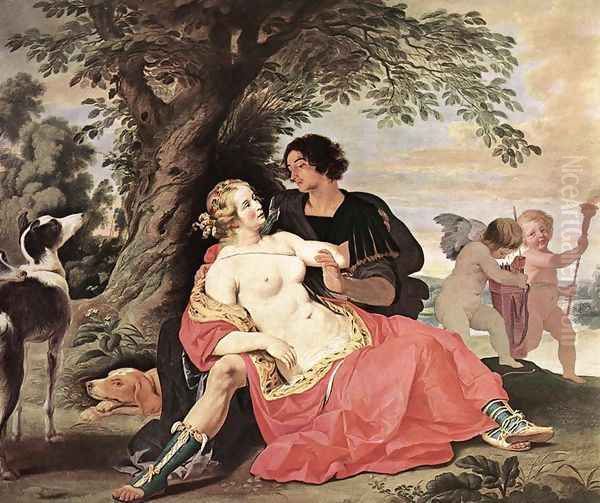
However, Janssens was not merely an imitator of Caravaggio. His interpretation of Caravaggism was filtered through a Northern sensibility and a respect for classical principles. Unlike some Italian Caravaggisti, Janssens rarely depicted the extreme grittiness or violence found in Caravaggio's work. His figures, while realistic, often retain a certain nobility and are composed with a sense of underlying order and balance derived from his study of the High Renaissance and classical sculpture.
His compositions are carefully constructed, often built upon stable pyramidal or diagonal structures. He demonstrated a mastery of anatomy and foreshortening, lending his figures convincing presence and movement. Furthermore, his Flemish training remained evident in his attention to texture and surface detail, rendering fabrics, flesh, and objects with tangible realism. His color palette, while often employing deep shadows, could also incorporate rich, saturated hues, particularly in draperies, adding a sensuous quality to his work.
Major Themes and Representative Works
Janssens excelled in history painting, the most prestigious genre of the time, encompassing religious narratives, mythological subjects, and allegorical scenes. His oeuvre reflects the demands of the Counter-Reformation Catholic Church, the interests of learned patrons fascinated by classical antiquity, and the civic pride of Antwerp.
Mythological Paintings
Mythology provided Janssens with ample opportunity to display his skill in depicting the human form, dynamic action, and complex narratives. One of his most celebrated works is Scaldis and Antverpia (also known as Scheldt and Antwerp), painted around 1609 for the Antwerp City Hall's Statenkamer (States Room). This large allegorical painting personifies the River Scheldt as a powerful river god and the city of Antwerp as a bountiful female figure, accompanied by a cornucopia symbolizing prosperity. The work showcases Janssens's monumental style, robust figures influenced by Michelangelo, and skillful integration of allegory and realism.
Another significant mythological work is Jupiter Rebuked by Venus (c. 1612-1615). This painting demonstrates Janssens's ability to convey complex emotions and relationships through gesture and expression. The composition, likely influenced by Italian Renaissance frescoes, features dynamic, foreshortened figures and a dramatic interplay of light and shadow, highlighting the tension between the powerful god and the assertive goddess.
The Origin of the Cornucopia (c. 1619) depicts nymphs filling the horn of plenty, a subject derived from classical myth associated with abundance and fertility. This work, sometimes linked to collaborations due to the richness of the still life elements, exemplifies Janssens's ability to blend mythological narrative with decorative richness. Venus and Adonis and Meleager and Atalanta are other examples where he explored themes of love, tragedy, and heroism from classical lore.
Religious Works
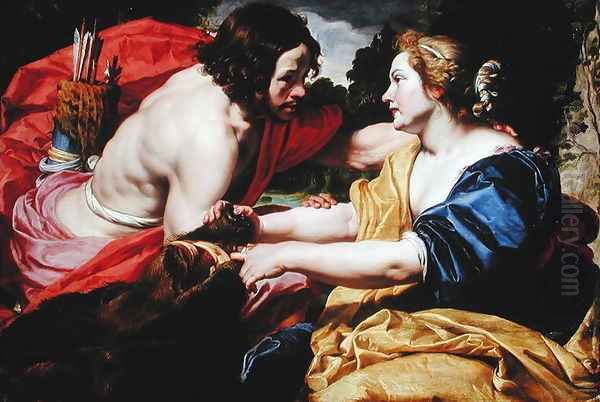
As a leading painter in staunchly Catholic Antwerp during the Counter-Reformation, Janssens received numerous commissions for altarpieces and devotional paintings. His religious works often combine the dramatic intensity learned from Caravaggio with the emotional piety required by the Church. The Entombment of Christ (c. 1610) is a powerful example, employing stark lighting and conveying profound grief through the expressive figures surrounding Christ's body. It invites comparison with Caravaggio's treatment of the same subject but possesses a distinct Flemish character.
The Penitent Magdalene (c. 1620s) reflects a popular Counter-Reformation theme, emphasizing repentance and divine mercy. Janssens depicts Mary Magdalene in quiet contemplation, often accompanied by symbolic objects like a skull and an ointment jar. His treatment balances sensuous beauty with spiritual introspection, using subtle lighting to enhance the mood. Other notable religious works include depictions of the Adoration of the Magi, Christ Crowned with Thorns, and various scenes from the lives of saints, all executed with characteristic force and clarity.
Allegorical Compositions
Janssens also proved adept at creating complex allegories, often commissioned for public buildings or private patrons seeking to convey specific virtues or concepts. Peace and Abundance Binding the Arrows of War (c. 1614), painted for the Antwerp City Hall, is a prime example. Created during the Twelve Years' Truce (1609-1621) in the Eighty Years' War, the painting celebrates the temporary cessation of hostilities. Personified figures of Peace and Abundance work together to neutralize the instruments of war, rendered with Janssens's typical solidity and clear narrative structure.
Another allegorical work, Concord, Charity and Sincerity (or similar titles), explores civic virtues through symbolic figures. These paintings often feature robust, classically inspired nudes or semi-nudes, demonstrating Janssens's mastery of the human form while conveying abstract ideals important to the social and political climate of Antwerp.
The Relationship with Rubens: Rivalry and Respect
The narrative of Abraham Janssens's career is inevitably intertwined with that of Peter Paul Rubens (1577–1640). Returning to Antwerp in 1608, Rubens quickly established a dominant position with his dynamic, large-scale workshop, energetic style, and international connections. While Janssens had been the leading figure, Rubens's arrival shifted the artistic landscape.
Art historical anecdotes, particularly those recorded by the later Dutch biographer Arnold Houbraken, paint a picture of intense rivalry, suggesting Janssens challenged Rubens to a painting competition, which Rubens diplomatically declined, or that Janssens grew bitter and dissolute out of jealousy. However, these stories likely contain embellishments and should be treated with caution. There is little contemporary evidence of open hostility, and Janssens continued to receive important commissions and maintain a respected position even during Rubens's ascendancy.
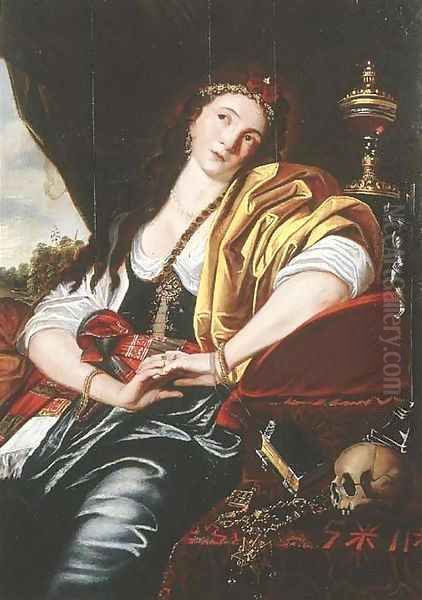
Stylistically, the two masters offered different approaches. Janssens's work often feels more static and sculptural compared to Rubens's swirling dynamism and fluid brushwork. Janssens emphasized strong contours, deliberate modeling, and often cooler, more contrasting light, whereas Rubens favored warmer palettes, softer transitions, and a greater sense of movement and unity. While Janssens's style did evolve, potentially showing some influence from Rubens's lighter palette and more complex compositions in the 1620s, he largely maintained his distinct artistic identity, rooted in his specific interpretation of Italian models and Flemish tradition. They represented two powerful, albeit different, currents within the Antwerp Baroque.
Workshop, Collaborations, and Influence
Like most successful masters of the period, Janssens operated a workshop to assist him with large commissions. While less documented than Rubens's extensive studio, Janssens trained several pupils who went on to have successful careers. Among the most notable were Gerard Seghers (1591–1651) and Theodoor Rombouts (1597–1637), both of whom became significant figures in Flemish Caravaggism, further developing the style their master had helped introduce to Antwerp. Other documented pupils include Michel Desubleo (or Michele Desubleo, also known as Michele Fiammingo, c. 1601–1676), who later worked in Italy, and Nicolas Régnier (Niccolò Renieri, c. 1591–1667), who also achieved considerable success in Italy, particularly Venice.
Janssens also participated in the common Antwerp practice of collaboration, where specialists would contribute specific elements to a single painting. He is known to have collaborated with still life and animal painters such as Frans Snyders (1579–1657) and Adriaen van Utrecht (1599–1652), who might add fruit, game, or animals to his mythological or allegorical scenes. He also collaborated with flower specialist Jan Brueghel the Elder (1568–1625) on occasion, integrating their respective talents into unified compositions. These collaborations highlight the interconnectedness of the Antwerp art world and the efficiency of its workshop system.
Janssens's influence extended beyond his direct pupils. His role in introducing and adapting Caravaggesque elements was crucial for the development of that style in Flanders. Artists like Jacob Jordaens (1593–1678), though primarily influenced by Rubens, also show an awareness of the powerful modeling and dramatic lighting characteristic of Janssens's work, especially in their earlier careers. Even the young Anthony van Dyck (1599–1641), before fully developing his elegant style under Rubens, experimented with Caravaggesque tenebrism that owed a debt to pioneers like Janssens.
Later Career and Legacy
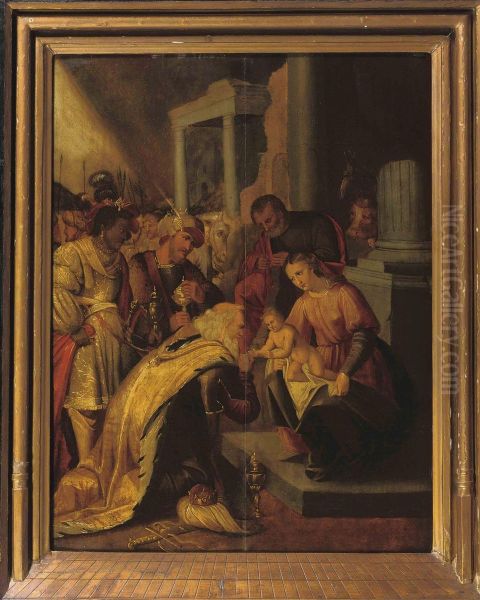
Abraham Janssens remained active as a painter until his death in Antwerp on January 25, 1632. He was buried in the city's Carmelite Church. While Rubens undoubtedly became the dominant force in Flemish art from the 1610s onwards, Janssens maintained a successful career, continuing to produce powerful works for churches and private collectors. His later works may show a slight lightening of the palette and perhaps a greater complexity in group compositions, possibly reflecting the pervasive influence of Rubens, but they retain his characteristic solidity and deliberate execution.
Art historically, Abraham Janssens is recognized as a major figure of the early Flemish Baroque. He was instrumental in transmitting the innovations of Italian art, particularly Caravaggism, to the North, but he did so in a way that was uniquely his own, blending it with classical ideals and Flemish traditions. His work provided a significant alternative to the style of Rubens, characterized by its strength, monumentality, and often intense psychological depth.
Though sometimes overshadowed in popular accounts by the sheer prolificacy and fame of Rubens, Janssens was a master of the highest caliber, admired by his contemporaries and influential on the next generation of Flemish painters. His paintings are held in major museums worldwide, including the Royal Museums of Fine Arts of Belgium in Brussels, the Kunsthistorisches Museum in Vienna, the Louvre in Paris, and the Hermitage Museum in St. Petersburg, attesting to his enduring importance. He remains a key artist for understanding the richness and diversity of painting in Antwerp during its golden age. His legacy lies in his powerful synthesis of styles and his contribution to the dramatic and emotive language of the Baroque.